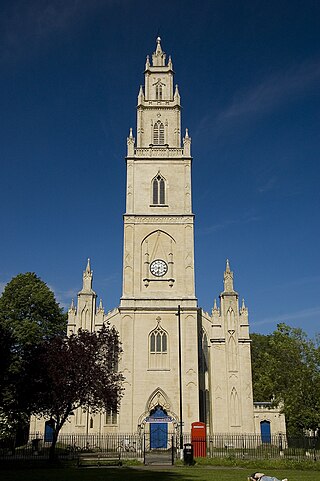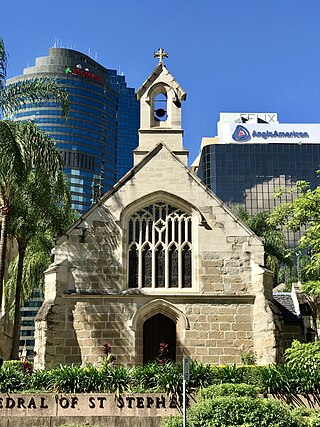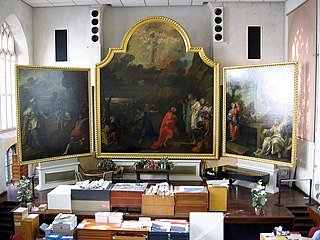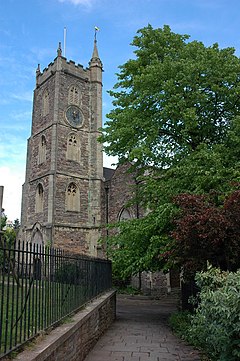
The Church of St Mary the Virgin, widely known as St Mary Redcliffe, is the main Church of England parish church for the Redcliffe district of the city of Bristol, England. The first reference to a church on the site appears in 1158, with the present building dating from 1185 to 1872. The church is considered one of the country's finest and largest parish churches as well as an outstanding example of English Gothic architecture. The church is so large it is sometimes mistaken for Bristol Cathedral by tourists. The building has Grade I listed status, the highest possible category, by Historic England.

St Luke's Church, more commonly known by locals as the bombed-out church, is a former Anglican parish church in Liverpool, England. It stands on the corner of Berry Street and Leece Street, at the top of Bold Street.
Haselbech is a village and civil parish in West Northamptonshire in England. At the time of the 2001 census, the parish had a population of 87 people. The population remained less than 100 at the 2011 Census and was included in the civil parish of Kelmarsh.

Bristol, the largest city in South West England, has an eclectic combination of architectural styles, ranging from the medieval to 20th century brutalism and beyond. During the mid-19th century, Bristol Byzantine, an architectural style unique to the city, was developed, and several examples have survived.

St John's Church, Ranmoor is a large parish church in Ranmoor, a suburb of the City of Sheffield, England. It is a Church of England church in the Diocese of Sheffield, and it is the second church to be built on this site after the original church was destroyed by fire in 1887. It has a 190-foot-tall (58 m) tower and spire, the second tallest church spire in Sheffield after the Cathedral Church of St Marie which is just 5 ft taller.
Thomas Paty was a British surveyor, architect and mason working mainly in Bristol. He worked with his sons John Paty and William Paty.
James Bridges was an English architect and civil engineer working in Bristol between 1757 and 1763. He designed Royal Fort House (1760), rebuilt St Werburgh's Church (1758–61) and began the rebuilding of both Bristol Bridge and St Nicholas' Church.

King Street is a 17th-century street in the historic city centre of Bristol, England.

St Paul's Church, a redundant church, gives its name to the surrounding St Paul's area of Bristol, England. It was built in the 1790s but fell into disuse and disrepair by its closure in 1988. It is recorded in the National Heritage List for England as a designated Grade I listed building.

Redland Parish Church is a Georgian church, built in 1742, in the Redland suburb of Bristol, England. It is a Grade I listed building.

There are 100 Grade I listed buildings in Bristol, England according to Bristol City Council. The register includes many structures which for convenience are grouped together in the list below.
There are 212 Grade II* listed buildings in Bristol, England.

Christ Church with St Ewen is a Church of England parish church in Broad Street, Bristol, England.

The Church of Holy Trinity is an Anglican church on Bell Hill in Stapleton, Bristol, England. It has been designated as a grade II* listed building.

St Peter's Church is in Chapel Street, Congleton, Cheshire, England. It is recorded in the National Heritage List for England as a designated Grade I listed building. It is an active Anglican parish church in the Diocese of Chester, the archdeaconry of Macclesfield and the deanery of Congleton. Its benefice is combined with those of St Stephen, Congleton, St John the Evangelist, Buglawton, and Holy Trinity, Mossley. Alec Clifton-Taylor includes it in his list of 'best' English parish churches. The Church Buildings Council included St Peter's in its group of 300 Major Parish Churches following research produced in 2016. [Pursell 2016]

St Michael's Church is a redundant church standing on the corner of Bridge Street and Pepper Street in the city of Chester, Cheshire, England. It is recorded in the National Heritage List for England as a designated Grade II listed building. The former church was previously used as a heritage centre, until March 2019, when it opened as Chester: A Life Story, a historical attraction tracing the life of Chester and its inhabitants over the last two thousand years. It was then reopened in 2021 as Sick To Death, a historical attraction depicting the journey of medicine through the ages.

St Michael and All Angels Church stands on Warhill overlooking the village of Mottram in Longdendale, Greater Manchester, England. The church is recorded in the National Heritage List for England as a designated Grade II* listed building. It is an active Anglican parish church in the diocese of Chester, the archdeaconry of Macclesfield and the deanery of Mottram.

St Stephen's Chapel, also known as the Pugin Chapel, and formerly known as Old St Stephen's Church, is a heritage-listed Roman Catholic former church, now chapel, located at 249 Elizabeth Street, Brisbane City, City of Brisbane, Queensland, Australia. It was designed by Augustus Pugin and built from 1848 to 1850 by Alexander Goold and Andrew Petrie.

Sealing the Tomb is a great altarpiece triptych by William Hogarth in the English city of Bristol. It was commissioned for St Mary Redcliffe in 1755. In the 19th century attempts were made to sell it, but it was given to the Bristol Fine Art Academy, which became the Royal West of England Academy. Its size made it difficult to display and it was rolled up and stored in the basement. In 1973 it was displayed in the ecclesiastical museum created in the war-damaged Church of St Nicholas. When the museum closed it was converted to offices; however the triptych remains in the building. It is on display to the public again after the church was re-consecrated in 2018.

Berkeley Crescent is a late 18th-century crescent of six Georgian houses with a private communal garden.
















